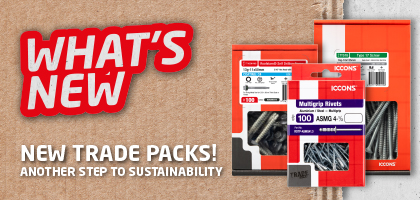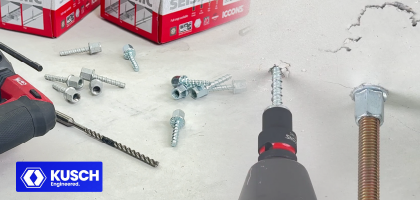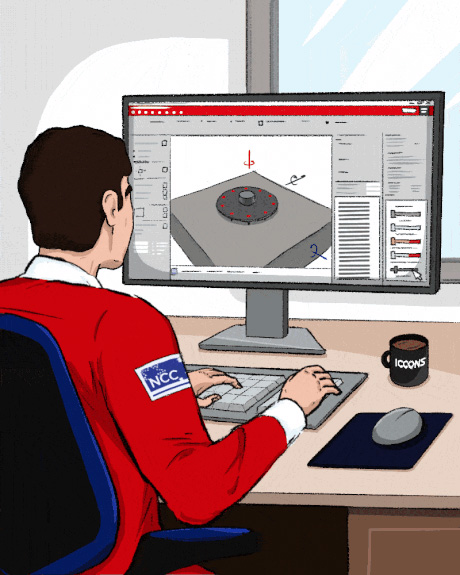If you own or operate a construction supply outlet, you may be eligible to supply ICCONS range of construction fastening supplies at wholesale prices!
- Log In
- Sitebox
- Contact
- Find a dealer
-
Anchoring
Anchoring
- Screw Bolts
- Thru-Bolt Stud Anchors
- FM753 - Heavy Duty Through Anchors
- ATS-EVO Heavy Duty Anchors
- STA-EVO Heavy Duty Anchors
- Hangerz
- Drop-In Anchors
- Suspension and Tie Wire Anchors
- Sleeve Anchors
- Panel Brace Anchors
- Friulsider Nylon Anchors
- Metal - Light Duty
- Nylon - Light Duty
- Plasterboard and Hollow Cavity Wall Anchors
- Plastic Wall Plugs and Spaghetti
- Strike Anchors
-
Pipe Clamps
Anchoring
-
Cast-In Anchors
Anchoring
- Shims and Other
-
Hollow Section Fittings
Anchoring
-
Adhesives
Adhesives
-
Nailing
Nailing
- Rivets
-
Screws
Screws
-
Self Drillers
Screws
- Self Drilling Bugle Head
- STET Aesthetic Architectural Tamper Resistant Screw
- Self Drilling Button Head
- Self Drilling Countersunk Head
- Self Drilling Countersunk Wing
- Self Drilling Flathead
- Self Drilling Hex Head
- Self Drilling Mushroom Head
- Self Drilling Pan Head
- Self Drilling Trade Packs
- Self Drilling Trade Tubs
- Self Drilling Wafer Head
- Self Drillers
- Type 17
- Collated
-
Decking
Screws
- Needle Point
- Chipboard
- Cyclonix
-
Painted Screws
Screws
- Painted - Needle Point Hex Head
- Painted - Self Drilling Button Head
- Painted - Self Drilling Flathead
- Painted - Self Drilling Hex Head
- Painted - Self Drilling Multiseal - 14 Gauge
- Painted - Self Drilling Trade Packs
- Painted - Self Drilling Trade Tubs
- Painted - Self Drilling Wafer Head
- Painted - Type 17 Cyclonix - 14 Gauge
- Painted - Type 17 Hex Head
- Painted Screws
- Muro - Collated Screw Solutions
-
Self Drillers
-
Drilling
Drilling
- Drilling - SDS Plus
- Drilling - SDS Max
- Dustless Drilling
-
Drilling Power Tool Accessories
Drilling
- Countersinking / Pre-Drilling Accessories
- Impact Fastdrive - Bit Holders
- Impact Fastdrive - Bit Kits
- Impact Fastdrive - Insert Bits
- Impact Fastdrive - Nut Setters
- Impact Fastdrive - Power (Double Ended) Bits
- Impact Fastdrive - Power Bits
- Standard Fastdrive - Bit Holders
- Standard Fastdrive - Insert Bits
- Standard Fastdrive - Nut Setters
- Standard Fastdrive - Power Bits
- Impact Sockets
- Drill Attachments
- Tile Bits
- Ratioquick Core Bits and Accessories
- Drilling Power Tool Accessories
- Metal / Wood / Concrete Kits
-
Diamond
Diamond
-
Tools
Tools
-
Other
Other
- Support & Downloads
- Partners
- Careers
- About
Dealer Login
The Insight: A Fire Rating Summary for Fasteners within Australian Standard 5216 (AS 5216)
06 June 2022
ICCONS is often asked, how do we design anchors for fire exposure if Australia’s post-installed concrete standard AS 5216 does not cover the design of fastenings for exposure to fire and durability?
Fortunately, AS5216 bases its design methodology on the European Code “EN 1992-4 Design of Fastening for use in concrete” and the European Code covers “Design of Fastenings under Fire Exposure”.
AS5216 adopts European Assessment Documents (EAD’s) for their anchor testing and encourage European Testing Assessments (ETA’s) for publishing the test results.
Below in table 1, there is a summary of both Australian Standard AS5216 and European Code EN1992-4.
Table 1: EN1992-4 and AS5216 Comparison
| Code | Mechanical Anchors | Chemical Anchors | ||||||
| General Testing Requirement | General Test Results Published | Fire Testing Requirement | Fire Results Published |
General Testing Requirement |
General Test Results Published |
Fire Testing Requirement |
Fire Results Published |
|
EN1992-4 |
EAD 330232 |
ETA |
EAD 330232 |
ETA |
EAD 330499 |
ETA |
EOTA TR 20, EN 1363-1 |
Separate Fire Assessment Report |
AS5216 |
EAD 330232 |
ETA |
Not Covered Yet (Adopt European) |
EAD 330499 |
ETA |
Not Covered Yet (Adopt European) |
||
As seen in table 1, for Post-installed Concrete Mechanical Anchors:
- EAD 330232 incorporates fire testing for mechanical anchors
- Note: EAD 330232 uses the “Standard Temperature/Time Curve” in accordance with conditions in EN 1363-1 Fire resistance tests - Part 1: General Requirements
- As EAD 330232 includes fire testing, Fire resistance results are published in Mechanical products respected ETA
- EN1992-4 (which AS5216 is based on) covers fire design for mechanical anchors
- EAD 330499 does not include fire testing
- Fire capacity of post-installed chemical anchors can be obtained through direct testing using the following European Standards:
- EOTA TR 20 Evaluation of anchorages in concrete concerning resistance to Fire
- EN 1363-1 Fire resistance tests - Part 1: General Requirements.
- As Fire testing is not in EAD 330499, the Fire capacity of post-installed chemical anchors have to be published in a separate Assessment Report
- EN1992-4 (which AS5216 is based on) covers fire design for anchors
For Post-installed Concrete Chemical Anchors:
To Summarise, with AS5216 not covering fire design for post-installed anchors, EN1992-4 may be adopted. Mechanical anchors fire exposure results can be found in their respective ETA while chemical anchors will have a published Assessment Report. ICCONS can provide these reports on request for any of our AS5216 approved anchors that are also Fire-rated.
As always, follow us on Instagram, Facebook and LinkedIn to stay in touch with other relevant updates!
Should you require any more information – please don’t hesitate to get in touch with our technical experts via [email protected] or alternatively call us on 03 9706 4344.
Need further support?
Get in touch with our technical experts today
Don't forget to follow us on Facebook, Instagram and LinkedIn to stay in touch with other relevant updates!
Latest articles
-
 20 May 2025
20 May 2025ICCONS Stands Proud as a Home-Grown Brand
With many iconic Australian fixing and fastening brands now in the hands of offshore giants, ICCONS stands firm. Australian owned and operated.
Read More -
 30 April 2025
30 April 2025What's New 🔥 New Recyclable Trade Pack & Trade Tub Packaging!
ICCONS® Takes Another Step Towards Sustainability with New Recyclable Packaging!
Read More -
 5 March 2025
5 March 2025Expert Tips on Seismic Anchoring: Insights from ICCONS and KUSCH
The importance of proper selection and installation of concrete screw anchors, including ICCONS’ Thunderbolt® PRO, in seismic-rated applications.
Read More


